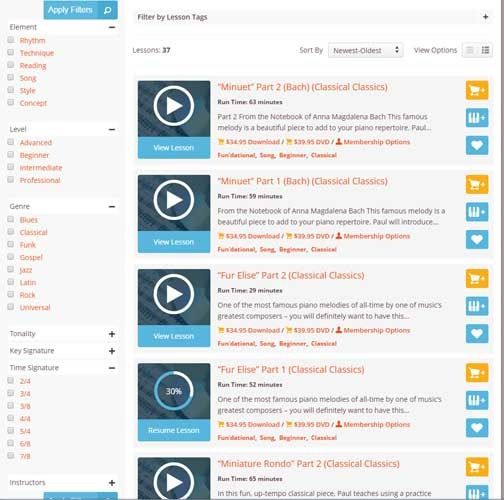 The past April I had the opportunity to attend my local Homeschool Expo and meet Andrew Pudewa from the Institute for Excellence in Writing (IEW). I wanted to thank him personally because I’m not sure I’d still be homeschooling if it weren’t for the products his organization has created. For this particular review we received Teaching Writing: Structure and Style and Student Writing Intensive Level B.
The past April I had the opportunity to attend my local Homeschool Expo and meet Andrew Pudewa from the Institute for Excellence in Writing (IEW). I wanted to thank him personally because I’m not sure I’d still be homeschooling if it weren’t for the products his organization has created. For this particular review we received Teaching Writing: Structure and Style and Student Writing Intensive Level B.
I don’t make that claim about not homeschooling lightly. Writing is my son’s most difficult subject from the actual act of putting pen to paper and his handwriting issues to organizing thoughts to coming up with creative ideas. I on the other hand am one of those girls that could fill a small notebook on a writing assignment. Because it came so easily to me I struggled with how to teach my son~~obviously saying “You just do it” wasn’t helping matters. We’d save writing for the last subject, because I wanted to get as much accomplished as possible before the whining or complete meltdowns ruined our day.
We’re both winners with IEW. My son’s writing assignments are broken into manageable baby steps. He’s spared from the idea that he needs to come up with a story that has never been thought up in the history of the world. I can let Mr. Pudewa do the teaching on the DVDs or I can follow the teaching guidelines in the manual.
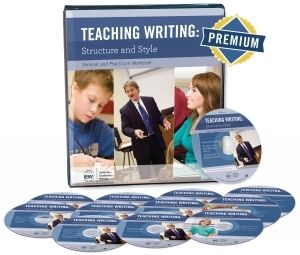 I first reviewed Teaching Writing: Structure and Style my third year on the TOS Crew, but the program has been entirely updated. I received twelve DVD’s stored in a book/folder with individual pockets for each disk (there are extra pockets on the back sides of each page so you could also store other IEW product disks in is as well). The first nine disks contain over 14 hours of workshops to teach you how to teach your kids. The remaining three discs have 5.5 hours showing how Mr. Andrew Pudewa teaches kids at four different learning levels. The second component of the course is a three ring binder with 234 pages of teaching tips, answers to frequently asked questions, student writing samples and more. Currently offered with the premium package is 1 year of access to streaming versions of the lecture recordings, audio recordings, and PDF files of classroom posters and source material for all nine units of the writing program. I found that I’d already received a lot of the material through IEW’s annual Twelve Days of Christmas giveaways, but new material will be added/updated every June.
I first reviewed Teaching Writing: Structure and Style my third year on the TOS Crew, but the program has been entirely updated. I received twelve DVD’s stored in a book/folder with individual pockets for each disk (there are extra pockets on the back sides of each page so you could also store other IEW product disks in is as well). The first nine disks contain over 14 hours of workshops to teach you how to teach your kids. The remaining three discs have 5.5 hours showing how Mr. Andrew Pudewa teaches kids at four different learning levels. The second component of the course is a three ring binder with 234 pages of teaching tips, answers to frequently asked questions, student writing samples and more. Currently offered with the premium package is 1 year of access to streaming versions of the lecture recordings, audio recordings, and PDF files of classroom posters and source material for all nine units of the writing program. I found that I’d already received a lot of the material through IEW’s annual Twelve Days of Christmas giveaways, but new material will be added/updated every June.
 We also received the Level B of the Student Writing Intensive curriculum. There are four discs with lessons and one with an overview of the entire program. A manila envelope is included in the set holding with both teacher material (course syllabus, DVD scene listings, Teacher’s Notes for each lesson) and student material ( that will be given to the student when called for throughout the course). The three ring binder for this set is meant to help the student organize his work with sections for Structural models, outlines, style charts and banned words list.
We also received the Level B of the Student Writing Intensive curriculum. There are four discs with lessons and one with an overview of the entire program. A manila envelope is included in the set holding with both teacher material (course syllabus, DVD scene listings, Teacher’s Notes for each lesson) and student material ( that will be given to the student when called for throughout the course). The three ring binder for this set is meant to help the student organize his work with sections for Structural models, outlines, style charts and banned words list.
It’s these last sections that is really pulling the writing out of my son. While Charles Dickens or Victor Hugo seem to squeeze in as many words as possible (Dickens at least was paid by the word), my son is the exact opposite. Because he will eventually have to write it himself (I act as his scribe during rough drafts), it’s an understatement to say he keeps his words to a minimum. When he begins to manipulate the sentences to make sure he’s included the “dress ups,” and now making sure that sentences start with something other than the subject, that he’s forced to expand his writing.
This is not our first go round with IEW (We’ve been through SWI-A and this year we did the first half of the Student Intensive Continuation Course (SICC-A). We jumped into Unit 6 Summarizing Multiple References, since we’d just wrapped up Unit 5 Writing From Pictures. Fritz watched the process on the DVD’s and we used the provided source material. By “virtually” participating in the class, he was able to take advantage of the brainstorming with other students. In the next lesson we did not use the source material provided. He needed to write an essay on the history of Dutch Ovens for a merit badge. I gathered a Lodge cast iron booklet, a cookbook on outdoor cooking and several internet article for him and we went through all the steps on our own. I don’t think his Royal Ranger Commander expected such craftsmanship in the essay, but as a homeschooling teacher I was thrilled.
We’ve moved on to Unit 7 Inventive Writing for another merit badge writing assignment. This time Fritz needed to write a devotion for his Bible merit so rather than use the SWI materials, I’m teaching him from what I had learned by watching the Structure and Style DVDs. Normally this kind of assignment would have caused a complete meltdown with crying and screaming. However, we are following Mr. Pudewa’s example of asking yourself questions to draw information out of your head and we created an outline before starting to write. Fritz jumped on the idea that there’s nothing we can do to work our way into heaven. For an analogy, he compared heaven to the top of the Gateway Arch. His first paragraph provides information about the Arch, the second covers various world records (high jump, pole vault) and other stunts people have tried to get to the top. The final paragraph compares the ticket you must buy to the free gift of salvation. With his permission I may share when it’s finished.
One of the reasons I was chosen for this review is that IEW has a heart to help special needs children. My son is an Aspie, and while most people associate Asperger's Syndrome with social awkwardness, they also have problems with writing. I already mentioned the actual act of putting pen to paper. According to the Jan/Feb 2013 issue of Autism Asperger’s Digest “The writing process involves skills in language, organization, motor control and planning, and sensory processing: four areas that are problematic for many individuals with ASD.” IEW provides the tools to help with the first two. We’re building vocabulary by banning simple words (good/bad, said, went) and creating lists of verbs and adjectives that create a stronger image or feeling. Organization is built into the program~~every unit begins with creating an outline of some form before writing the first sentence.
When we started it was definitely slow baby steps. According to Mr. Pudewa, there’s no such thing as giving too much help. When my son couldn’t identify key words, I would reread the source paragraph sentences and verbally emphasize the best choices. I usually write his key word outlines based on the words he underlines. He dictates his first draft to me. While he’s demonstrated mastery of the dress ups, when it comes to sentence openers he’ll often say “I’m open to suggestions”~~ my cue to offer help. Because it requires so much of his energy to physically write, he really needs a mental break—using source samples so he doesn’t have to come up with original ideas provides that. He is slowly learning to come up with his own material (the Unit on developing a story based on a series of three pictures for example).
I’ll be the first to admit that opening a box with all this material in it is intimidating. Understand that you don’t have to learn it all yourself before you begin teaching your children. If I were a newbie, I would begin by watching the Overview Disc that comes with the SWI set. Then I’d let Mr. Pudewa do the teaching—at least to start, with the Student Writing Intensive materials. At the same time, I’d watch the same unit on the Teaching Writing: Structure and Style discs on my own~~and do the practicum work so that you really understand what your child is being asked to do. Be patient. Remember the motto “Mastery and then one more thing.” Then as both teacher and student grew more comfortable with the process, you could expand the source material to other subjects you were teaching, history or science perhaps. If you or your child are struggling in any area be sure and sign up for the forum kept on the IEW website. I’ve received quick responses to my questions and found some tips from other IEW users.
I would also highly recommend the Fix It! Grammar series. The two programs work together to reinforce concepts. For example in Fix It! Grammar one of my son's weekly tasks was to choose the best strong verb (one of the dress ups) of the week. Some weeks in Fix It! there are two sentences with the instruction to combine them with a who/which. We also learned some sentence openers in grammar before they came up in the writing program.
The Institute for Excellence in Writing has earned a special spot in our homeschool. I’m keeping all my materials in hopes that someday my grandchildren with use them! When a new homeschooler comes to me not knowing where to turn, IEW is one of the first vendors I recommend they check out. Their products, indeed the company itself, are truly among the best of the best.
In case you’re interested in some of my other IEW reviews, try the links below.


Don't miss a thing!
Subscribe to Ozark Ramblings and get my posts in your inbox.


 For better or worse, math is one of those subjects you can never get away from. It’s not like the lifecycle of a butterfly, which you can cover once and never study again (or maybe skip entirely). You start with counting blocks and continue throughout a student’s education. And for some mothers, this can be intimidating because it wasn’t their best subject. When you can’t teach what you never learned yourself, what are you to do? You may need to turn to outside help like
For better or worse, math is one of those subjects you can never get away from. It’s not like the lifecycle of a butterfly, which you can cover once and never study again (or maybe skip entirely). You start with counting blocks and continue throughout a student’s education. And for some mothers, this can be intimidating because it wasn’t their best subject. When you can’t teach what you never learned yourself, what are you to do? You may need to turn to outside help like 

 to begin, there is a diagnostic test (gray bar at the top of the list). You can get immediate feedback on what your student already knows and what should be reviewed (or learned for the first time). I didn’t notice this test at first and had Fritz start at the beginning~~he really could have jumped ahead because he’s already mastered the order of operations.
to begin, there is a diagnostic test (gray bar at the top of the list). You can get immediate feedback on what your student already knows and what should be reviewed (or learned for the first time). I didn’t notice this test at first and had Fritz start at the beginning~~he really could have jumped ahead because he’s already mastered the order of operations. 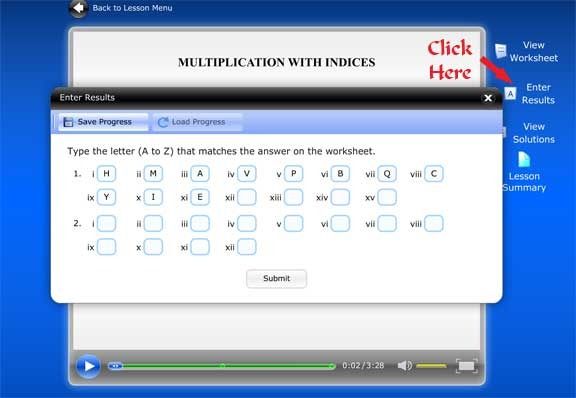
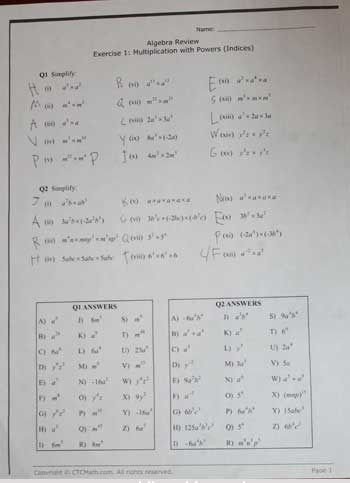
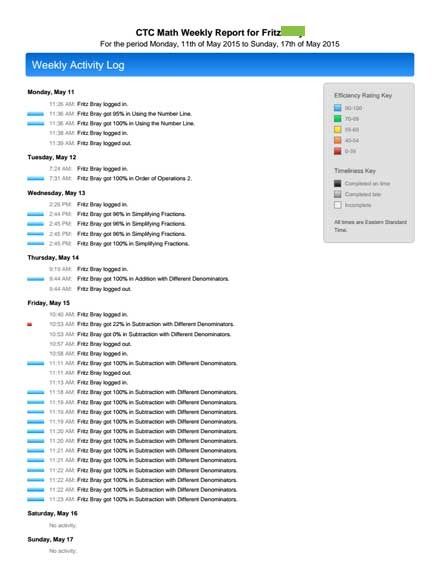 To that end, I received a weekly report via email that showed Fritz’s progress. It let me know how long he’d worked on math and his grades. You may notice the small red dot on the report or the red line on the screenshot of the lesson topics. On that particular day I’d called Fritz during math time to come see a mama fox and her kit running through our back yard. He missed seeing the pair and blamed it on math. He had been entering his answers and when he returned to the computer he hit submit in a fit of anger. When he’d calmed down he tried to return to the exercise and finish submitting his answers, but the damage was done. He’s initial score was 22 percent. I’ve found no way for a parent to “reset” the system. He could repeat the activity over and over and raise his score, but it’s weighted to the first submission and he’ll never get to 100. So that day Fritz learned a life lesson (repercussions of acting in anger) as well as algebra~~Lesson learned. I do think a parent reset might be a good feature to add, especially given that this program is delivered via the internet. I don’t know what would happen to a students records if a storm or something else interrupted the connection during a lesson.
To that end, I received a weekly report via email that showed Fritz’s progress. It let me know how long he’d worked on math and his grades. You may notice the small red dot on the report or the red line on the screenshot of the lesson topics. On that particular day I’d called Fritz during math time to come see a mama fox and her kit running through our back yard. He missed seeing the pair and blamed it on math. He had been entering his answers and when he returned to the computer he hit submit in a fit of anger. When he’d calmed down he tried to return to the exercise and finish submitting his answers, but the damage was done. He’s initial score was 22 percent. I’ve found no way for a parent to “reset” the system. He could repeat the activity over and over and raise his score, but it’s weighted to the first submission and he’ll never get to 100. So that day Fritz learned a life lesson (repercussions of acting in anger) as well as algebra~~Lesson learned. I do think a parent reset might be a good feature to add, especially given that this program is delivered via the internet. I don’t know what would happen to a students records if a storm or something else interrupted the connection during a lesson.

 The past April I had the opportunity to attend my local Homeschool Expo and meet Andrew Pudewa from the
The past April I had the opportunity to attend my local Homeschool Expo and meet Andrew Pudewa from the  I first reviewed
I first reviewed  We also received the
We also received the 
 Salvete, amici Latinae! That’s how my son and I have been starting every Monday morning for the past several weeks. We’ve been students together, using the
Salvete, amici Latinae! That’s how my son and I have been starting every Monday morning for the past several weeks. We’ve been students together, using the 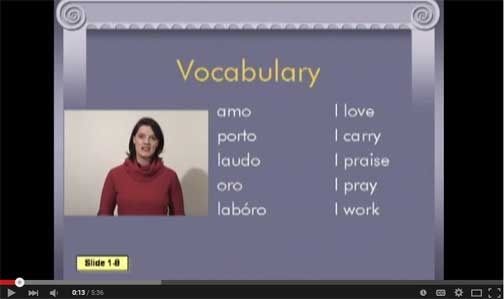
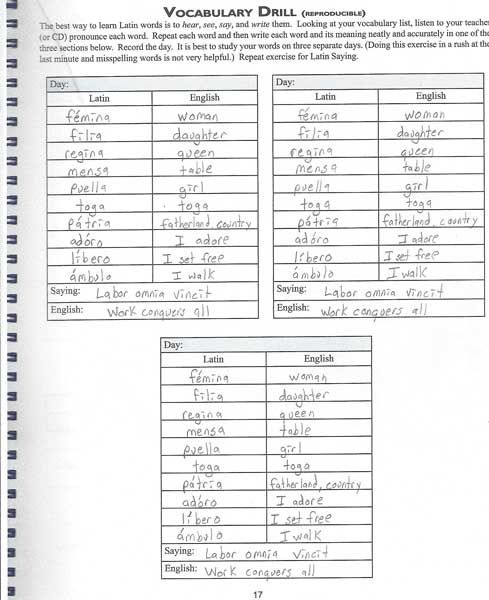 In the Teacher Manual is a reproducible worksheet for vocabulary drill. Three times a week we would write our new vocabulary words and their English translations—usually on Mondays after the video, Tuesdays, and Thursdays. The back side of the page had tables to write and practice conjugations and declensions. On Wednesday we worked in the Student Book (my son in the book and I used notebook paper) and Friday was quiz day (quizzes and tests can be found in the Teacher Manual). Every fifth lesson is a cumulative review, after which comes a test. We’ve only had one so far and I was surprised to see Roman history included. There is a page or two of history and some maps in the Teacher Manual, but it seems most of the questions assume you are also using Memoria Press’s Famous Men of Rome curriculum.
In the Teacher Manual is a reproducible worksheet for vocabulary drill. Three times a week we would write our new vocabulary words and their English translations—usually on Mondays after the video, Tuesdays, and Thursdays. The back side of the page had tables to write and practice conjugations and declensions. On Wednesday we worked in the Student Book (my son in the book and I used notebook paper) and Friday was quiz day (quizzes and tests can be found in the Teacher Manual). Every fifth lesson is a cumulative review, after which comes a test. We’ve only had one so far and I was surprised to see Roman history included. There is a page or two of history and some maps in the Teacher Manual, but it seems most of the questions assume you are also using Memoria Press’s Famous Men of Rome curriculum. opposite side has the English translation and part of speech. There are also flash cards for the Latin phrases and cue words for conjugating and declining. I punched holes in our set and kept them on a ring. Throughout the week we’d flip to a word and see if we knew the definition or the translation for the English side. I realized just how useful these cards were after I lost the set for lesson three. I ended up making my own version~~they were that helpful, at least for this old brain.
opposite side has the English translation and part of speech. There are also flash cards for the Latin phrases and cue words for conjugating and declining. I punched holes in our set and kept them on a ring. Throughout the week we’d flip to a word and see if we knew the definition or the translation for the English side. I realized just how useful these cards were after I lost the set for lesson three. I ended up making my own version~~they were that helpful, at least for this old brain. Last year my son started taking online piano lesson and it quickly became his favorite school subject. As I watched him, I once again felt the remorse of giving up piano lessons as a kid. Now thanks to JazzEdge I have a second chance with another of their online courses—
Last year my son started taking online piano lesson and it quickly became his favorite school subject. As I watched him, I once again felt the remorse of giving up piano lessons as a kid. Now thanks to JazzEdge I have a second chance with another of their online courses— I began by going through the 30 Day Piano Success Playbook—this is a whirlwind refresher course on reading music, rhythm, scales and chords (if you’re truly a beginner, you might not master the names of the lines and spaces of the bass and treble staffs in a five minute lesson). I also learned to play two original songs and one classic (My Romance by Richard Rodgers). No need to keep track of which day you’re on~~the dashboard will show you which lessons are completed.
I began by going through the 30 Day Piano Success Playbook—this is a whirlwind refresher course on reading music, rhythm, scales and chords (if you’re truly a beginner, you might not master the names of the lines and spaces of the bass and treble staffs in a five minute lesson). I also learned to play two original songs and one classic (My Romance by Richard Rodgers). No need to keep track of which day you’re on~~the dashboard will show you which lessons are completed.